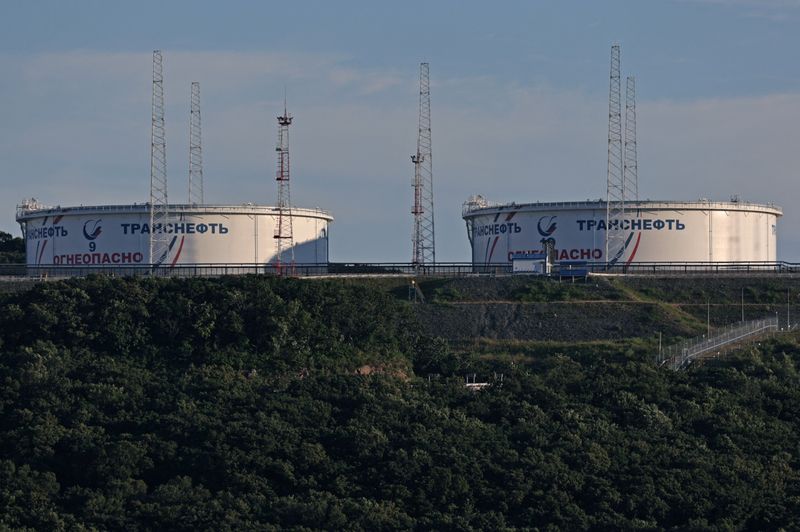Commodities
Oil rises $1 as Middle East crisis, inflation fight in focus


© Reuters. A view shows oil tanks of Transneft oil pipeline operator at the crude oil terminal Kozmino on the shore of Nakhodka Bay near the port city of Nakhodka, Russia August 12, 2022. REUTERS/Tatiana Meel/file photo
By Robert Harvey
LONDON (Reuters) -Oil prices rose by more than $1 on Tuesday after sliding in the previous session as markets weighed Middle East tensions against demand worries and rising OPEC supply.
futures rose $1.33, or 1.75%, to $77.45 a barrel at 1131 GMT, while U.S. West Texas Intermediate crude futures gained $1.29, or 1.82%, to $72.06 a barrel.
Geopolitical tensions in the Middle East and an ongoing supply outage in Libya offered support to prices on Tuesday, analysts said.
“On the supply side, there are some bullish factors from the closure of Libya’s largest oilfield, which has affected around 0.3 million barrels per day of oil production,” said Suvro Sarkar, energy sector team lead at DBS Bank.
Some major shipping firms are still avoiding the Red Sea. Germany’s Hapag-Lloyd will continue to divert vessels around the Cape of Good Hope in the wake of maritime attacks by Yemeni Houthi militants, it said on Tuesday.
Regarding the Gaza war, the Israeli military has said its fight against Hamas will continue through 2024, worrying markets that the conflict could grow into a regional crisis that could disrupt Middle Eastern oil supplies.
U.S. Secretary of State Antony Blinken told Israeli leaders there was still a chance of winning acceptance from their Arab neighbours if they create a path to a viable Palestinian state.
The oil benchmarks are rebounding from 3% and 4% losses incurred on Monday respectively, following sharp cuts by top exporter Saudi Arabia to its official selling prices (OSP).
“The question is whether the Saudi move of reducing OSPs to a 27-month low is also a sign of a potential increase in oil supply implying serious discord within OPEC+,” PVM analyst Tamas Varga said.
On the demand side, German industrial production unexpectedly fell in November according to the federal statistics office, marking a sixth consecutive monthly decline.
Output fell by 0.7% after analysts polled by Reuters had predicted a 0.2% rise.
In the U.S., Federal Reserve Governor Michelle Bowman on Monday said she now sees U.S. monetary policy as “sufficiently restrictive” and signalled her willingness to support eventual interest-rate cuts as inflation eases.
Core inflation data on Thursday could offer fresh clues regarding the fight against inflation, while the market is also awaiting U.S. inventory data from the American Petroleum Institute industry group due later on Tuesday.
Commodities
Oil prices rise; U.S. crude inventories plunge, Russia-Ukraine truce eyed
Commodities
India’s Reliance to stop buying Venezuelan oil over US tariffs, sources say
Commodities
Oil prices climb on Venezuela supply worries

 Forex3 years ago
Forex3 years agoForex Today: the dollar is gaining strength amid gloomy sentiment at the start of the Fed’s week

 Forex3 years ago
Forex3 years agoUnbiased review of Pocket Option broker

 Forex3 years ago
Forex3 years agoDollar to pound sterling exchange rate today: Pound plummeted to its lowest since 1985

 Forex3 years ago
Forex3 years agoHow is the Australian dollar doing today?

 Cryptocurrency3 years ago
Cryptocurrency3 years agoWhat happened in the crypto market – current events today

 World3 years ago
World3 years agoWhy are modern video games an art form?

 Commodities3 years ago
Commodities3 years agoCopper continues to fall in price on expectations of lower demand in China

 Economy3 years ago
Economy3 years agoCrude oil tankers double in price due to EU anti-Russian sanctions























